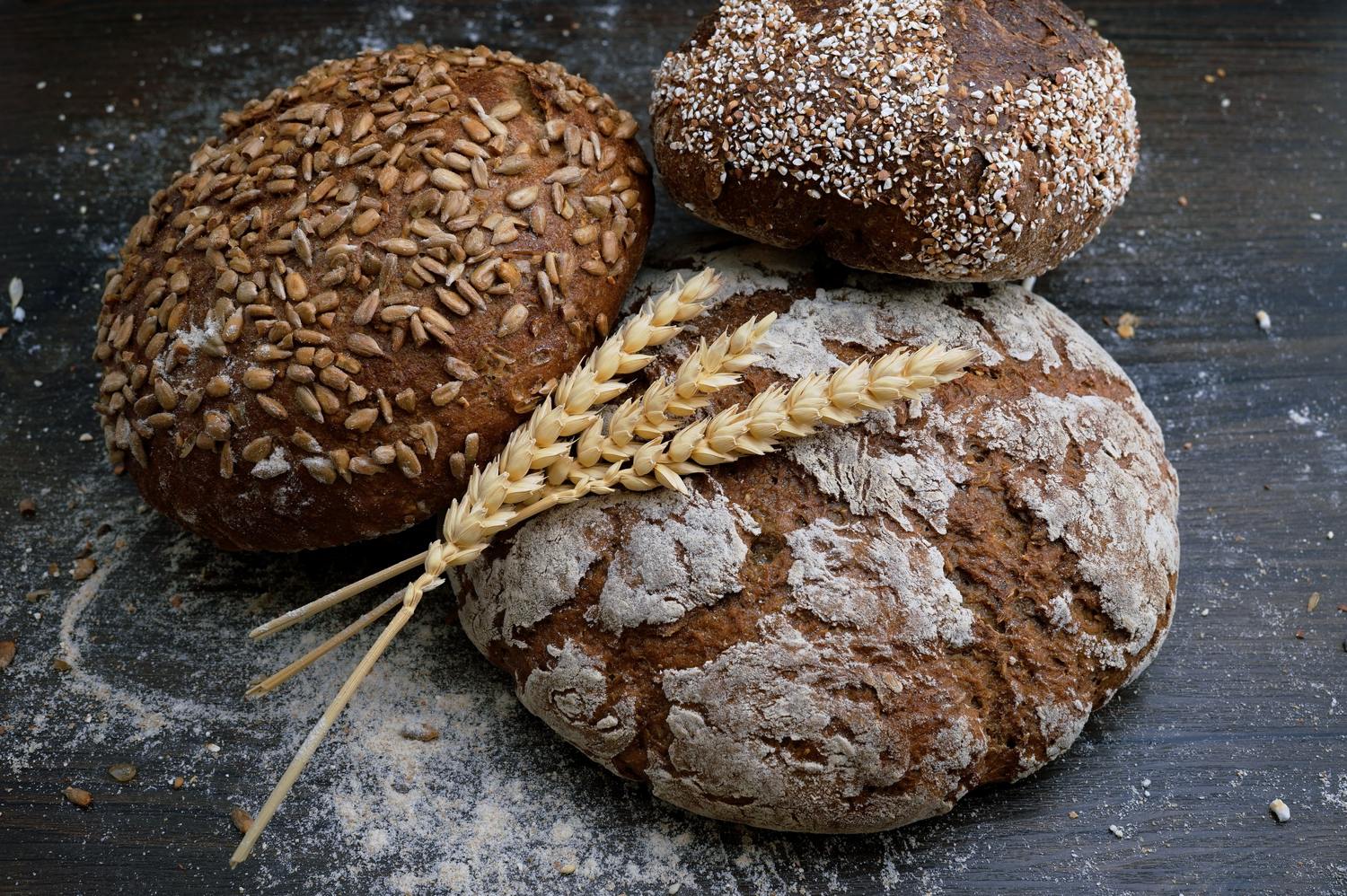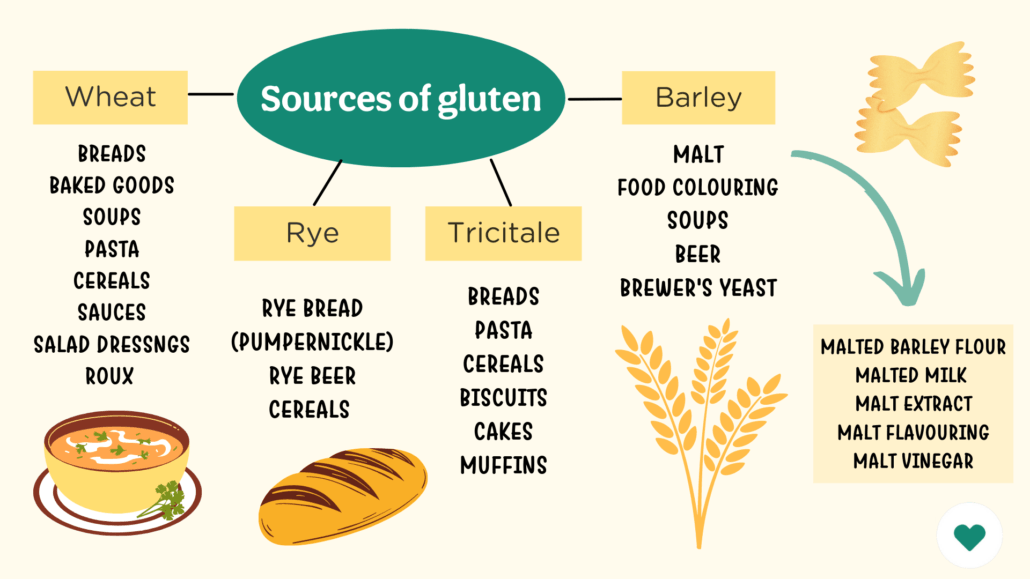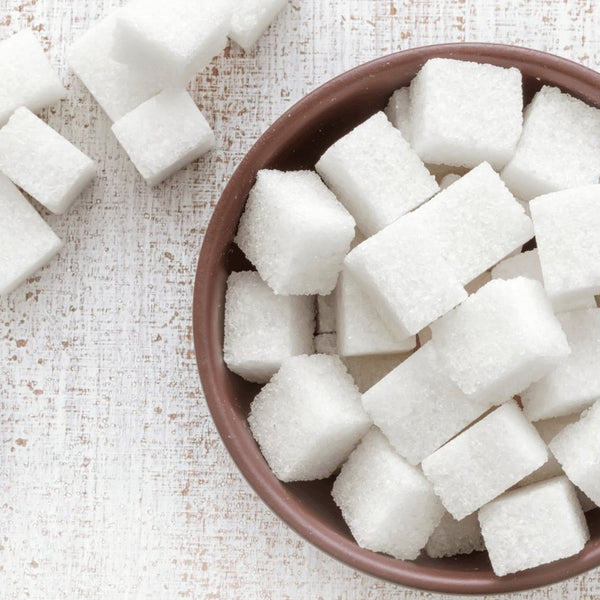
What is gluten and what does it do?
What is gluten?
Have you ever heard of gluten but not exactly sure what it is? In this article we’ll cover the most important information on everything you need to know about gluten (at least for starters). Gluten is a protein found in wheat plants, rye, barley and triticale (a cross between rye and barley). Gluten can sometimes be present in oats, not naturally occurring but because they’re being processed with other foods that contain gluten. It is common in foods such as breads, pizza, pasta and cereal.
Why is gluten used?
Gluten is used for its binding properties, making the food have a more solid structure (less crumbly). If you’ve ever seen pizza or bread dough before, the stretchy consistency is possible because of the gluten. Without gluten, the dough would rip more easily. So overall, gluten is used for texture and flavour enhancement purposes.
Sources of gluten

Sometimes you see ‘gluten free’ on a food package and think to yourself does that mean it’s healthier? Eating gluten isn’t harmful for most people without gluten intolerance.
Gluten is not bad for those without a gluten intolerance condition such as coeliac or gluten sensitivity. However, studies have shown that gluten intolerance can develop any time at any age for both males and females. A gluten free diet doesn’t help lose weight. Weight loss can occur when you make healthier food choices rather than choosing a gluten free diet specifically!
With most foods that we eat, sometimes we may not think much about what’s inside it. It is always a good idea to make sure that what you’re eating is truly what’s best for you. This is about mindful eating.
Mindful eating
Mindful eating isn’t just about knowing what we eat but also understanding how it affects us whether that be making us feel good or bad. Here's a fun fact, the term conscious (as in ‘conscious’ or ‘mindful eating’) originated from the Latin word scīre which means “to understand'' or “to know''. The best way to try mindful eating is to pay attention to your digestive experience when you eat certain foods. How does it make you feel? This goes a long way with helping us to not only physically feel good but also mentally and emotionally too.
The ultimate goal of choosing the right foods is to sustain a healthy, balanced life which promotes longevity. With the right foods for your body, it’ll help you power through your busy day by providing you with a sustainable source of energy that doesn’t leave you feeling bad. And remember, your health is the first step to achieving your biggest dream goals!
Keep reading to find out about what gluten really is and what it does to our body!
The history of gluten

The origins of gluten came about 10000 years ago when wheat grains were first cultivated by human civilisation in the Fertile Crescent of southwest Asia. Primal wheat species were speculated to have been cultivated at least as early as 9000 B.C. That’s ages ago!
Back then, wheat wasn’t used in abundance until the industrial revolution where it became prominent in food diets. With the increase of transport systems domestically and globally, it was easy and inexpensive to mill and distribute wheat flour. During the Great Depression, nutritious wholefoods such as meat and dairy were scarce in the United States. This scarcity in nutritious food allowed for wheat to become the more sustainable alternative which kick-started the creation of processed pre-packed foods.
In the 1960s, wheat foods were considered healthy. Slowly, in the late 1970s and 1980s, wheat was commonly used in fast foods. In the 1990s, when the health food pyramid came about, wheat products such as bread, pasta and other grain products became a staple and were recommended for daily consumption. The evolution of gluten has brought about coeliac disease, a condition in which the immune system reacts abnormally to gluten causing the intestinal tracts to become inflamed and flattened.
Why is gluten not good for us?
People with coeliac disease have an immune reaction to gluten, causing inflammation and damage in the intestinal tracts and other parts of the body. It is for this reason that a gluten free diet is needed to prevent inflammation of the intestinal tracts and associated symptoms. In Australia, approximately over 355,000 people have coeliac disease. That’s approximately 1 in 70 Australians.
Symptoms include:
- Persistent gastrointestinal symptoms e.g. diarrhea, constipation, nausea, vomiting, flatulence, cramping, bloating, abdominal pain, steatorrhea
- Prolonged fatigue, weakness and lethargy
- Iron deficiency anemia and/or other vitamin and mineral deficiencies
- Failure to thrive or delayed puberty in children
- Unexplained weight loss
- Severe or recurrent mouth ulcers
- Skin rashes such as dermatitis herpetiformis
For people without coeliac disease, gluten doesn’t provide any extra nutrients to the body. Although a person can be tested and have a negative result for coeliac, they can be “gluten-sensitive” meaning that they experience temporary symptoms such as bloating, diarrhea, or abdominal pain whenever gluten is consumed. Being “gluten sensitive”or “gluten intolerant” can be caused by wheat allergy which can be diagnosed by skin testing. Gluten should be avoided if it makes you feel unwell no matter if you’ve been tested for coeliac or not.
The difference between gluten intolerance, gluten sensitivity and coeliac disease
Gluten intolerance, gluten sensitivity and coeliac disease all share similar symptoms but they’re not the same. Distinguishing these causes can help you better understand your body and seek proper management strategies if necessary.
Coeliac disease
Coeliac disease is a genetic autoimmune disorder that causes discomfort to gluten, a protein found in wheat, barley, rye and oats. The consumption of gluten triggers a body response which damages the villi of small finger-like projections on the small intestines lining. As a result, the lining becomes inflamed and flattened, reducing the ability of the small intestines to absorb nutrients properly. It is for this reason that symptoms such as bloating and abdominal pain can occur.
Both men and women of any age can develop coeliac disease if they have a genetic predisposition. Genetic predisposition refers to the increased likelihood of developing a certain disease due to the mutation of one or more genes. It’s unsure what the causes of coeliac disease are but it can be related to family history (genetic inheritance), environmental factors and other health conditions. Coeliac disease cannot be cured but can be managed with a gluten free diet.
Coeliac disease can be tested by a blood test and test for antibodies present in people with coeliac disease and accompanied with a small bowel biopsy.
Gluten intolerance
Gluten intolerance can refer to both coeliac disease and non-coeliac gluten sensitivity. It is a broad term used to describe the body's inability to safely process gluten. Some early signs indicating gluten tolerance include feeling bloated, abdominal pain and nausea. When conditions persist, it is recommended to seek medical help.
Gluten sensitivity
Gluten sensitivity often gets used interchangeably with gluten intolerance but there is a difference. This refers to a non-coeliac condition which affects the body in a similar way to coeliac disease but does not cause long term harm to the body. A gluten sensitive person would feel bloated or discomfort in the abdominal region temporarily.
Some other symptoms of non-coeliac gluten sensitivity include:
- Foggy mind
- Diarrhea
- Fatigue
- Drop in blood pressure
- Pain in abdomen or joints
What vitamins does your gluten free diet lack?

With coeliac disease and gluten sensitivity, these conditions can make it difficult for the small intestine to adequately absorb nutrients. As a result, nutrients such as vitamins, minerals, proteins, fats and carbohydrates can potentially be lacking.
Furthermore, many gluten free products are often high in carbs and sugar to compensate for the bland and dry taste. It’s mindful to note that not all gluten free foods are low in carbs! They are generally not modified (compared to gluten containing products) so they lack vital nutrients.
Common nutrients not absorbed easily for people with coeliac disease
- Iron
- Calcium
- Folate
- Vitamin B12
- fat-soluble vitamins A, D, E, K
Many people with coeliac disease are also lactose intolerant because the villi in the small intestines are unable to process the enzymes from dairy products. That’s why with the removal or reduction of dairy consumption, this can result in calcium deficiencies.
To compensate for deficiencies in vitamins and nutrients due to poor absorption, eating whole foods like fruits, nuts, vegetables and meat can help. As your body becomes used to a gluten free diet, absorption of nutrients should improve.
See some examples below.
Vitamins:
- Vitamin B12 - meat, fish, poultry
- Vitamin A - green leafy vegetables (e.g., spinach), carrots, sweet potatoes
- Vitamin D - seafood (salmon, sardines, shrimp)
- Vitamin E - green leafy vegetables, sunflower seeds, almonds
- Vitamin K - green leafy vegetables, broccoli, brussel sprouts
Minerals:
- Iron - meat, soybeans, lentils
- Calcium - dairy products, green leafy vegetables, almonds, sardines
- Magnesium - pumpkin seeds, almonds, spinach, sunflower seeds, black beans
At PBCo, our products are gluten free however, they are also low in carbs and have no added sugar. Made from all natural premium ingredients, our products are packed with freshness and wholesomeness. We want to ensure you’re getting the right foods for your health needs AND feel great too.
Eating a healthy gluten free diet

What are the common foods that contain gluten?
Common foods that contain gluten include breads, pastas, noodles, cakes, pies and pastries, breakfast cereals and cookies. Most of the time wheat gluten is added to act as a thickening agent to enhance flavour and colour. A good tip to identify and avoid foods and drinks that contain gluten would be to look at the drink or food label to see if there is wheat, barley or rye. As a further precaution, avoid foods unless they claim to be gluten free or made from corn, rice or soy grains.
What about gluten free foods at restaurants and at home?
To avoid cross contamination, it is a good idea to store gluten containing food and gluten free foods separately. Ensure all cookware and utensils are being cleaned thoroughly before usage. When choosing to dine out at restaurants, if you are coeliac, plan ahead and double check the menu and the restaurant if they have gluten free options available. For non-coeliac gluten intolerant individuals, consuming gluten foods won’t cause permanent damage to the body but may cause irritable symptoms. Overall, it’s a good idea to do your research and check what the cooking processes are as different cuisines have different levels of gluten in their dishes.
One of the most popular gluten free alternatives to wheat flour is almond flour. Almond flour is also low in carbs, has a delicious nutty taste, it adds moisture to your baked goodies and keeps them fresh for longer. Plus it's high in protein and fat to keep you feeling fuller for longer.
At PBCo, we want to help our customers feel their best by offering better, healthier options. From breads to sweet treats and pizza bases, all of our products are made with natural premium ingredients. Even better, they are gluten free, soy free and have no added sugar, helping you sparkle from the inside out.
What’s next?
There you have it, all about gluten and how it affects us in one article! Gluten is abundant in modern diets but it isn’t the be all and end all if you’re unable to consume gluten. There are many whole food alternatives you can take to accommodate for nutrient deficiencies in a gluten free diet. Remember that the point here is to swap but don’t stop. There's no need to make healthy eating boring! Be your own inspiration and find out what’s best for you, and of course the way you want it.
Are you coeliac or gluten sensitive? Do you think avoiding gluten and embarking on a gluten free diet is the right choice for you? Whatever your answer may be, the next time you see or hear about gluten, you'll know what it is. Being food conscious is important in helping us live healthier and ultimately happier too. If you stumbled across this article by chance or are looking to change the way you approach your health journey, we hope you learned something meaningful! If you notice an odd feeling when consuming food and drinks with gluten, it’s a good idea to speak to someone about it.


